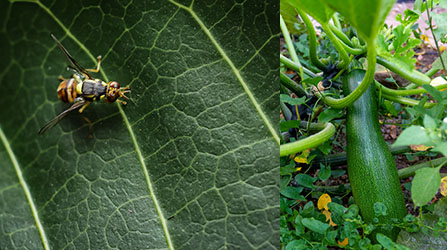MELON FLY (Bactrocera Cucurbitae)
What and Why: The melon fly (Bactrocera cucurbitae) is a fruit fly that is a major agricultural pest in Hawai‘i. It lays eggs inside of fruits via a tiny hole, causing the fruit’s growth to be stunted and unfit to be sold to consumers. Prior to its invasion of the islands, crops in the gourd family were widely grown for local consumption and some were exported to California. Unfortunately, the presence of melon fly eggs cannot easily be identified visually by humans.
Plants are known to emit volatile chemicals when they are under attack by infection, pests or other physical force. Our proof-of-concept project will assess whether dogs can be trained to detect the volatile chemicals specific to fruits being under attack by melon flies. Current management techniques include protective coverings around the fruits and baited traps. Pesticides are not very effective for melon flies.
Results of the project were promising, and future applications could include screening plants in organic farms and ports of entry/exit. Detection in farms would enable the early destruction of infected fruits before the insects pupate and emerge as flies (which would reproduce and create more flies). Removal of infected fruits from an intact plant would also route more nutrients to uninfected fruits on the remaining plant. Detection in ports would be a bio-security protocol that would potentially allow certain crops to be exported again.
Where: In the United States, melon flies are only known to be in the Hawaiian islands. Our initial project was conducted on the island of ‘Oahu.
Who: This project was proposed to us by entomology Masters student Morgan Pugh of the University of Hawai‘i. We worked closely with her to conduct our proof-of-concept project. The dogs that participated in the project included Morganʻs dog Winnie and volunteer pet dogs from our Nose Work for Conservation program. The dog training and testing portion of the project was completed in March 2021, and the study is currently being reviewed by an entomological journal for potential publication. We look forward to sharing the results and study with you in the near future.

